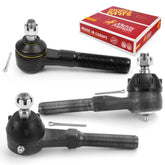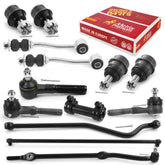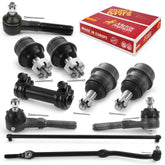Is It Safe to Drive With a Bad Tie Rod End?

When it comes to vehicle safety, steering is one system you cannot compromise on. At the heart of that system is the tie rod end, a small but vital component that connects the steering rack to the steering knuckle. Without it, your wheels wouldn’t turn properly, your car wouldn’t stay aligned, and driving would quickly become dangerous.
But what happens when a tie rod end goes bad? Can you keep driving, or is it time for immediate replacement? Let’s explore this in detail.
What Is a Tie Rod End and Why Is It Important?
The tie rod end acts as the final link in the steering system. It allows the wheels to pivot as you steer while maintaining a secure connection between the suspension and steering rack.
Key functions include:
- Translating steering input – your wheel movements are sent directly to the wheels.
- Maintaining wheel alignment – keeping tires pointed in the correct direction.
- Absorbing road movement – the ball-and-socket design allows flexibility over bumps and turns.
Without properly functioning tie rod ends, your car cannot track straight, respond predictably, or maintain tire health.
What Causes a Tie Rod End to Fail?
Tie rod ends are built to last, but like any wear item, they eventually degrade.
Common causes include:
- Normal wear and tear – constant steering input and suspension movement wear down the joint.
- Exposure to road conditions – potholes, salt, mud, and debris accelerate wear.
- Lack of lubrication – some tie rod ends are greasable, but sealed versions can dry out over time.
- Accidents or impacts – hitting a curb or deep pothole can bend or crack the component.
Symptoms of a Bad Tie Rod End
Recognizing early signs can save you from costly repairs—or worse, unsafe driving conditions. Watch for:
- Loose steering or wandering – the wheel doesn’t feel connected to the road.
- Clunking or knocking noises – especially while turning or going over bumps.
- Uneven or rapid tire wear – poor alignment caused by a failing tie rod.
- Vibration in the steering wheel – noticeable when accelerating or turning.
- Difficulty keeping the car straight – constant correction needed on highways.
Is It Safe to Drive With a Bad Tie Rod End?
The straightforward answer: No.
Here’s why:
- Alignment issues – A bad tie rod causes wheels to point in different directions, pulling the car off course.
- Tire damage – Misalignment quickly eats away at tire tread, reducing grip and increasing blowout risk.
- Loss of control – In severe cases, a tie rod end can separate completely, disconnecting your steering from the wheel. This makes the vehicle uncontrollable.
Even if your car is still drivable, every mile with a bad tie rod end puts you closer to a potential breakdown or accident.
When Should You Replace a Tie Rod End?
If you notice any of the symptoms above, replacement should not be delayed. A failing tie rod end affects not only your steering but also the health of connected parts like control arms, ball joints, and tires.
This is where Metrix Premium Chassis Parts comes in. Our high-quality tie rod ends and complete steering & suspension kits are engineered for strength, fitment, and reliability.
With options designed for easy installation, you can choose to handle the replacement yourself or have your mechanic install it.
Finding the exact part you need is simple with the Search Module at metrixpremiumparts.com. Add to cart, ship to your doorstep, and you’re ready to restore safe and precise steering.
Final Thoughts
Driving with a bad tie rod end is unsafe, period. This small part has a huge impact on handling, tire life, and overall vehicle safety. If you notice the warning signs, schedule an inspection or handle the replacement as soon as possible.
After all, your steering system is your lifeline on the road—and it deserves top priority.
Follow us on social media and sign up at our website for notifications about new posts and opportunities.
Previous Article: Brake Pads Or Rotors: When Is It Time To Replace Them?









